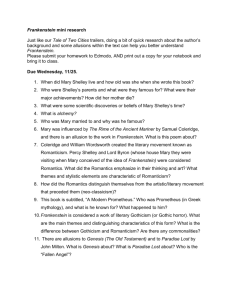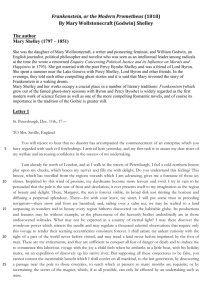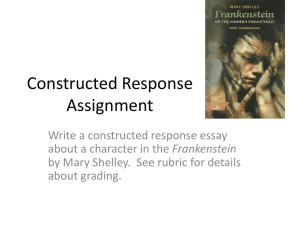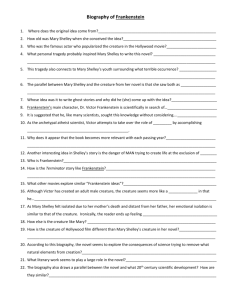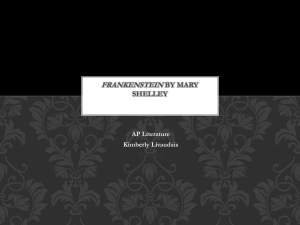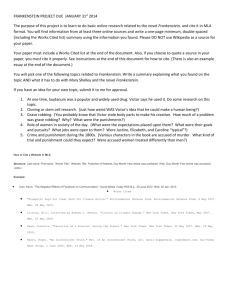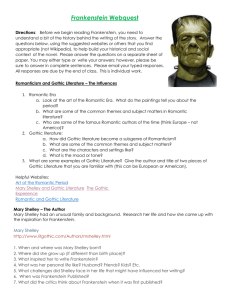Doe Jane Doe Mrs. Beard English 1302 16 February 2015
advertisement
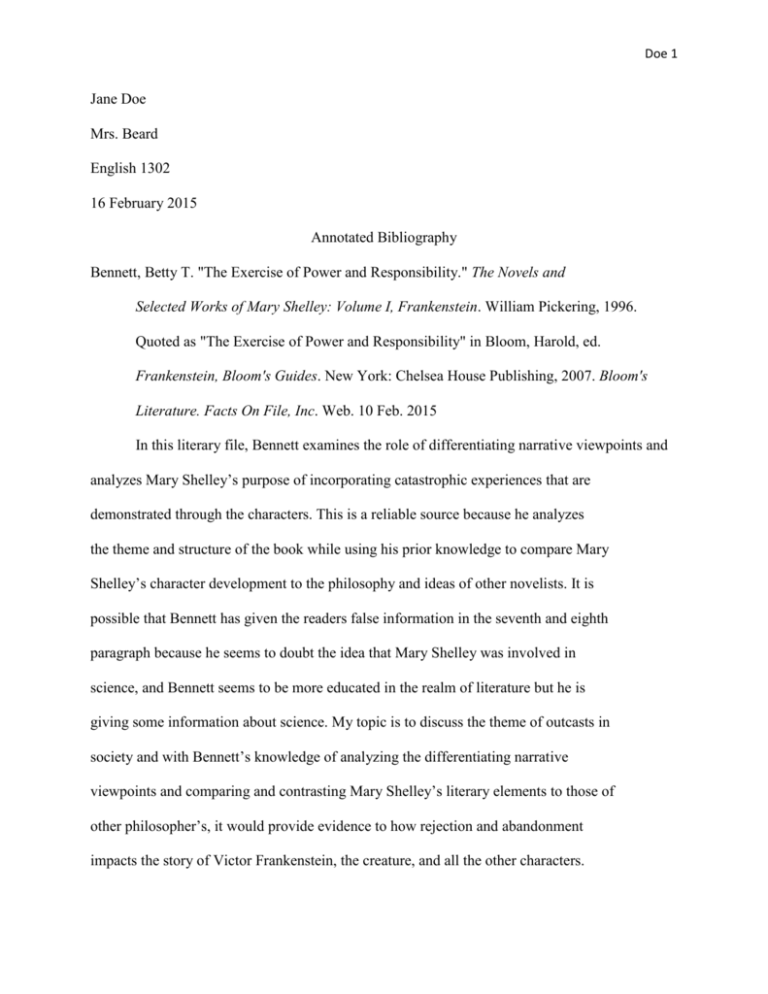
Doe 1 Jane Doe Mrs. Beard English 1302 16 February 2015 Annotated Bibliography Bennett, Betty T. "The Exercise of Power and Responsibility." The Novels and Selected Works of Mary Shelley: Volume I, Frankenstein. William Pickering, 1996. Quoted as "The Exercise of Power and Responsibility" in Bloom, Harold, ed. Frankenstein, Bloom's Guides. New York: Chelsea House Publishing, 2007. Bloom's Literature. Facts On File, Inc. Web. 10 Feb. 2015 In this literary file, Bennett examines the role of differentiating narrative viewpoints and analyzes Mary Shelley’s purpose of incorporating catastrophic experiences that are demonstrated through the characters. This is a reliable source because he analyzes the theme and structure of the book while using his prior knowledge to compare Mary Shelley’s character development to the philosophy and ideas of other novelists. It is possible that Bennett has given the readers false information in the seventh and eighth paragraph because he seems to doubt the idea that Mary Shelley was involved in science, and Bennett seems to be more educated in the realm of literature but he is giving some information about science. My topic is to discuss the theme of outcasts in society and with Bennett’s knowledge of analyzing the differentiating narrative viewpoints and comparing and contrasting Mary Shelley’s literary elements to those of other philosopher’s, it would provide evidence to how rejection and abandonment impacts the story of Victor Frankenstein, the creature, and all the other characters. Doe 2 Bentley, Colene. "Family, Humanity, Polity: Theorizing the Basis and Boundaries of Political Community in Frankenstein." A Quarterly for Literature and the Arts, Volume 47, Number 3 (Summer 2005): 325–351. Quoted as "Family, Humanity, Polity: Theorizing the Basis and Boundaries of Political Community in Frankenstein" in Bloom, Harold, ed. Mary Wollstonecraft Shelley, New Edition, Bloom's Modern Critical Views. New York: Chelsea House Publishing, 2008. Bloom's Literature. Facts On File, Inc. Web. 10 Feb. 2015 In this article, Bentley discusses the theme of rejection, the relationship of the community, and wants the readers to understand why relationships have a direct link to the feeling of abandonment and rejection. Bentley also breaks down her ideas into three different sections that analyze the role of humanity, family, justice, and history to emphasize how all of these are tied together and impact society. This is a reliable source because Bentley understands Mary Shelley’s point of constructing a book based on the notion of how community impacts individual characters. Bentley is reliable because she uses her cumulative literary knowledge to analyze and summarize the main points in the novel. Although Bentley is a reliable source, in some cases Bentley is using her own opinions to back up her ideas and arguments, and that could lead to misinterpretation of Mary Shelley’s real point. This article can help support my topic because the topic is about analyzing how Mary Shelley’s theme of rejection and abandonment figure in the lives of the characters. I will use in my essay by interpreting Bentley’s critical analysis to help support my argument that outcasts are a peril to society. Doe 3 Birkhead, Edith. "Later Developments of the Tale of Terror." 1921. Quoted as "Later Developments of the Tale of Terror" in Bloom, Harold, ed. Mary Shelley, Bloom's Classic Critical Views. New York: Chelsea House Publishing, 2008. Bloom's Literature. Facts On File, Inc. Web. 10 Feb. 2015 In this critical analysis, Birkhead analyzes how Mary Shelley uses some elements of a gothic novel but mostly constructed her book Frankenstein by imitating the novels of other gothic writers. In this analysis, Birkhead also talks about the idea from philosophers like Godwin. Birkhead is a reliable source because she tends to argue against Mary Shelley and brings out underlying themes and problems that Mary Shelley has put in the novel, which helps the reader visualize and understand different aspects of the novel. Although Birkhead is a reliable source, Birkhead tends to destroy Mary Shelley’s credibility by saying things like Mary Shelley wrote “her tale in a clumsy framework” and that the letters at the beginning of the book were unnecessary and distracted the reader from the effect that horror and suspense were supposed to provide. Birkhead’s analysis would help my topic because Birkhead talks about elements of a gothic novel and how Mary Shelley based her novel on the ideas of philosophers. The use of Birkhead’s analysis would help me because Birkhead talks about how gothic novels are based on the same elements, and that would imply that novels with a theme of outcasts and abandonment would yield similar end results. Doe 4 Jordanova, Ludmilla. "Melancholy Reflection: Construction an Identity for Unveilers of Nature." In Frankenstein: Creation and Monstrosity. Reaktion Books, 1994. Quoted as "Melancholy Reflection: Construction an Identity for Unveilers of Nature" in Bloom, Harold, ed. Frankenstein, Bloom's Guides. New York: Chelsea House Publishing, 2007. Bloom's Literature. Facts On File, Inc. Web. 10 Feb. 2015 In this article, Jordanova discusses the how Mary Shelley created a melancholy aspect throughout the novel and Jordanova also explores the internal conflicts of the main character, Victor Frankenstein. Jordanova also analyzes Shelley’s text on some key chapters, and then analyzes the problems with science in that time period. This is a reliable source because Jordanova can interpret and determine the tone and true meaning from Mary Shelley’s passages. Although Jordanova gives a lot of good and relevant information, Jordanova includes too much information on different subject matters. In this article, Jordanova critically analyzes Mary Shelley’s purpose and point, which is the literary aspect, but also examines the credibility of scientists in that time, and additionally talks about the history of the scientist’s interest in natural knowledge. This article would be useful in my essay because Jordanova determines that seclusion, reclusiveness, passion, absence of satisfaction, the quest for knowledge, and varying responses all factor into how Victor Frankenstein and the creature act. The key themes that Jordanova discovered in Mary Shelley’s novel include instability, uncertainty, and ambiguity would support my idea that with all three themes combined, a character is left with the feeling of abandonment and rejection. Doe 5 Zimmerman, Lee. "Frankenstein, Invisibility, and Nameless Dread." American Imago: Studies in Psychoanalysis and Culture, Volume 60, Number 2 (2003): 135–158. Quoted as "Frankenstein, Invisibility, and Nameless Dread" in Bloom, Harold, ed. Mary Wollstonecraft Shelley, New Edition, Bloom's Modern Critical Views. New York: Chelsea House Publishing, 2009. Bloom's Literature. Facts On File, Inc. Web. 10 Feb. 2015 In this critical analysis, Zimmerman analyzes and examines the conflicts of Victor Frankenstein, which creates the consequence of a monster that is a reflection of him. Zimmerman mostly focuses on how Victor Frankenstein felt abandonment and unloved by his parents and as he created his monster, the monster also gained some of Victor’s traits and also felt abandonment from his creator. This is a reliable source because Zimmerman goes into depth about the origins of Victor’s feeling of abandonment and how it progresses and impacts every action and thought in his life and Zimmerman also compares Mary Shelley’s development of her characters to those of other writers and novelists. I will use Zimmerman’s analysis in coordination with the philosophies of John Locke, and Jean-Jacque Rousseau that living creatures are born good, but experiences and social interaction corrupts our individual rights and destroys our morals. Zimmerman’s analysis also ties into my topic and is relevant because Zimmerman focuses on why Victor began to felt rejected by his father, the quest for more knowledge to make his family proud, and how his creation led to the death of all his loved ones, which ultimately left him, secluded and abandoned.

